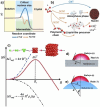Insight into nanocrystal synthesis: from precursor decomposition to combustion
- PMID: 36128523
- PMCID: PMC9425161
- DOI: 10.1039/d2ra05222a
Insight into nanocrystal synthesis: from precursor decomposition to combustion
Abstract
Nanotechnology-based synthesis of nanoscale materials has appealed to the attention of scientists in the modern scientific community. In the bottom-up approach, atoms start to aggregate/agglomerate and form nuclei within the minimum and maximum supersaturation range. Once nuclei are generated above the critical-free energy/radius, the growth is initiated by obeying the LaMar model with a slight extra simple growth by diffusion advancement. The in situ real-time liquid phase analysis using STEM, AFM, and XAS techniques is used to control precursor decomposition to the nanocrystal formation process and should be a non-stoppable technique. Solution combustion synthesis (SCS) is a time-/energy-efficient self-sustained process that produces mass-/ion transport active porous materials. SCS also permits the synthesis of evenly distributed-doped and hybrid-nanomaterials, which are beneficial in tuning crucial properties of the materials. The growth and development of nanocrystals, dehydrating the sol in the presence of a surfactant or/and fuel results in combustion once it arrives at the ignition temperature. Besides, the kinetic and thermodynamics controlled architecture-directing agent-assisted SCS offers colloidal nanocrystal framework formation, which is currently highly applicable for energy devices. This short review provides insightful information that adds to the existing nanocrystal synthesis process and solution combustion synthesis and recommends future directions in the field.
This journal is © The Royal Society of Chemistry.
Conflict of interest statement
There are no conflicts to declare.
Figures


















Similar articles
-
Solution Combustion Synthesis of Nanoscale Materials.Chem Rev. 2016 Dec 14;116(23):14493-14586. doi: 10.1021/acs.chemrev.6b00279. Epub 2016 Sep 9. Chem Rev. 2016. PMID: 27610827
-
Real-Time Electron Microscopy of Nanocrystal Synthesis, Transformations, and Self-Assembly in Solution.Acc Chem Res. 2021 Jan 5;54(1):11-21. doi: 10.1021/acs.accounts.0c00678. Epub 2020 Dec 14. Acc Chem Res. 2021. PMID: 33315389
-
Green and scalable production of colloidal perovskite nanocrystals and transparent sols by a controlled self-collection process.Nanoscale. 2015 Jul 21;7(27):11766-76. doi: 10.1039/c5nr02351c. Epub 2015 Jun 24. Nanoscale. 2015. PMID: 26104322
-
Insights into ZnO-based doped porous nanocrystal frameworks.RSC Adv. 2022 Feb 16;12(10):5816-5833. doi: 10.1039/d1ra09152b. eCollection 2022 Feb 16. RSC Adv. 2022. PMID: 35424565 Free PMC article. Review.
-
Molecular Combustion Properties of Nanoscale Aluminum and Its Energetic Composites: A Short Review.ACS Omega. 2020 Dec 22;6(1):17-27. doi: 10.1021/acsomega.0c03387. eCollection 2021 Jan 12. ACS Omega. 2020. PMID: 33458455 Free PMC article. Review.
Cited by
-
A critical mini-review on doping and heterojunction formation in ZnO-based catalysts.RSC Adv. 2024 May 29;14(25):17338-17349. doi: 10.1039/d4ra02568g. eCollection 2024 May 28. RSC Adv. 2024. PMID: 38813127 Free PMC article. Review.
-
Synthesis of copper-silver-zinc oxide nanocomposites for 4-nitrophenol reduction: doping and heterojunction.RSC Adv. 2023 Feb 2;13(7):4523-4529. doi: 10.1039/d2ra07845g. eCollection 2023 Jan 31. RSC Adv. 2023. PMID: 36760313 Free PMC article.
References
Publication types
LinkOut - more resources
Full Text Sources
Miscellaneous

